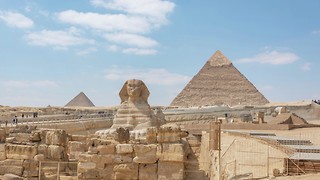Art: Discoveries at the Fitzwilliam
Annie Forbes is overwhelmed by this wondrous exhibition, bringing together art and science

A blurry photograph of an Antarctic volcano from Captain Scott’s 1911 Antarctic Expedition stars alongside an Ichthyosaur unearthed by the Victorian palaeontologist Mary Anning and her loyal terrier, Tray.
A one hundred and twenty million year old ammonite flanks a case containing 22 minutely different varieties of snow goggles. Following an incredible reception in London, the exhibition 'Discoveries: Art, Science and Exploration' has arrived at the Fitzwilliam Museum.
From the everyday to the ground-breaking, the artistic to the scientific, this exhibition revolves around the concept of human enquiry. In a sense, upon passing through its doors, the visitor embarks on their own voyage of discovery, as they are confronted with a smorgasbord of arresting and quirky artefacts. Selected from the five million objects held in Cambridge museums, each of the objects on show in this carefully curated exhibition has its own unique beauty and story to tell.

The sheer diversity on show here is incredible. In total, eight university museums have collaborated to produce the exhibit. It’s a highly eclectic mix of contributors, including Kettle’s Yard, the Museum of Zoology, the Whipple Museum of the History of Science, The Polar Museum and Cambridge University Botanic Garden. And yet, all of these objects work brilliantly in symphony, and have clearly been curated by a master eye.
The mingling of science and art is a constant theme throughout the exhibition. Henry Moore’s early stone carving 'Head' provides a glimpse of an artist still in very much the process of self-discovery, his primitive experimentations anticipating the enormous bronzes he became famous for after the First World War. In the same vein, a collection of Henri Gaudier-Brzeska’s sketches nicely illustrates his progression from naturalism to abstraction and cubism, the proteic forms of his early nudes replaced by the angular, quirky self-portraits of the artist smoking a pipe. This is an exhibition in which the stories not only of objects and artists but also of their discovery by enthusiastic patrons and collectors are in plain sight: Gaudier-Brzeska and Moore were championed by Ede, who went on to found Kettles Yard.

Many of the objects on show are incredible not only aesthetically, but also as evidence of pioneering scientific endeavour. Pressed plants and illustrations from Henslow’s Botanic Garden and Herbarium are the product of a tireless enthusiast, their fragile grace belying their scientific importance. 'An Allegorical Monument to Sir Isaac Newton' by Giovanni Battista Pottoni is a little-known gem which enjoys a rare public appearance. In the painting, religious adoration, scientific fact and artistic fantasy blur, as the beam of refracted light cutting across the canvas is by a crowd of figures plucked from the depths of history. Elsewhere, a seventeenth century table orrery from the Whipple Museum is a different kind of masterpiece. Constructed to demonstrate the motions of the earth, moon and sun, it’s absolutely stunning to look at, a delicately exquisite construction of mahogany and brass.
The history of some these artefacts are wonders in themselves, and there is a strong sense that we are only getting as tantalising glimpse of their full stories. The orrery comes complete with a pine box in which it was transported across the country and set up for wealthy patrons and their children. Look closer and you will realise that the Dodo skeleton is actually a composite creation, assembled from individual bones which Mauritius islanders recovered long after the bird had become extinct, by wading through a swamp named the 'sea of dreams'.
Alongside its varied testaments to human endeavour and imagination, there is a darker side to this exhibition which gives it an edge. The dodo is the most recognisable as a striking reminder of the profound damage wreaked by colonisers bent on exploring new lands. The intricate workmanship of an Islamic snakes and ladders board, its delicate Arabic script inlaid on dark wood with mother of pearl, is tempered by the circumstances of its collection: it was acquired by a British coloniser after the Indian rebellion of 1857. A beautiful collection of butterflies, used in 1915 by Reginald Punnet in his pioneering work on genetics, bear pins through the hearts of the butterflies.
Yet this murkier aspect of the act of discovery is constantly remedied by the extent of the dedication, vision, and purity of purpose of the men and women who devoted their lives to their passions. The engineer James Nasmyth’s nineteenth century studies of the moon, made over a 30 year study period from his kitchen garden, are incredible not just in their meticulous detail to scientific accuracy, but in their stark and bleak beauty. Hugh Edwin Strickland’s attempt at a graphical classification of living birds, created with the rigorously methodical goal of stabilising zoological terminology, actually have a wonderfully naïve and childlike quality; the product of the kind of unique imagination that makes a true innovator.

An excuse to visit the Fitzwilliam is always welcome, and Discoveries is an absolute gem of an exhibition. Gradually, the eclectic mix of artefacts it contains are assimilated into a joyous and captivating celebration of human enquiry, edged by unease at its potential to cause harm as well as furthering advancement. This exhibition isn’t large, but the incredibly well chosen selection here is enough to keep you engrossed for a day, if not more. At the exit, a sign proclaims that only the tiniest fraction of the objects in Cambridge’s public museums are on public display. The mind boggles at the endless stories that lurk in storage, just waiting for their chance to be told.
Discoveries: Art, Science and Exploration from the University of Cambridge Museums is at the Fitzwilliam Museum from Tuesday 27 May to Sunday 27 July 2014. Admission is free.
 News / Oxbridge miss out on top 3 in university rankings for first time19 September 2025
News / Oxbridge miss out on top 3 in university rankings for first time19 September 2025 Features / Cambridge SU: has-been or never-was?16 September 2025
Features / Cambridge SU: has-been or never-was?16 September 2025 Comment / Dear finalists, please have fun19 September 2025
Comment / Dear finalists, please have fun19 September 2025 Arts / A walking tour of Art Deco Cambridge16 September 2025
Arts / A walking tour of Art Deco Cambridge16 September 2025 News / Ludwig filming returns to Cambridge17 September 2025
News / Ludwig filming returns to Cambridge17 September 2025









